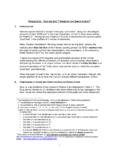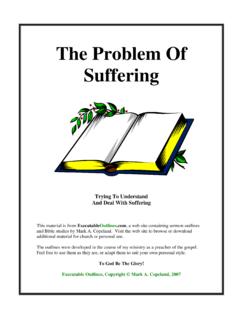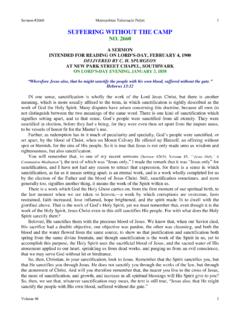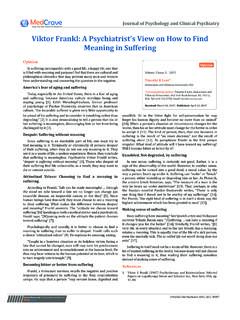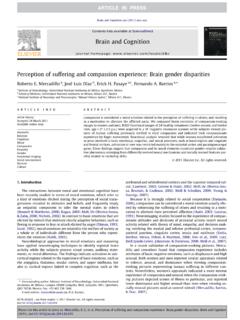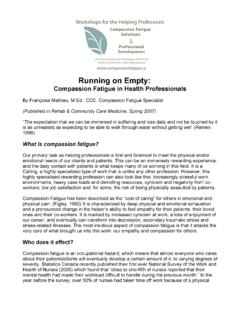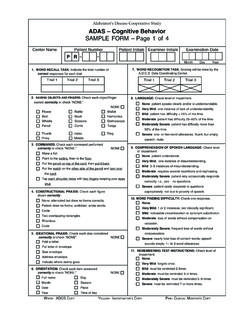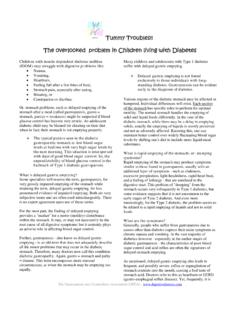Transcription of יִדְּבַע ַחיִשָׁמ ma 'ah - The Jewish Home
1 1 WHO IS THE SUFFERING SERVANT IN ISAIAH 53 ? PART I - THE Jewish INTERPRETATION: VALID OR NOT?1 I. INTRODUCTION The Book of Isaiah contains four passages commonly known as the Four Servant Songs: (1) Isaiah 42:1-4, (2) Isaiah 49:1-6, (3) Isaiah 50:4-9, (4) Isaiah 52:13-53:12. Three of these Four Servant Songs (#1, #2, #4) explicitly use the Hebrew term , (avDI), My servant,2 while in #3 such terminology is absent. Yet, the description of the subject's characteristics in #3 is so strikingly similar to those of the one to which the other three passages refer as , that it is included in the set of four.
2 These Four Servant Songs are considered as passages of exceptional expressive beauty (especially in the Hebrew language) and great religious depth. According to the major Jewish commentators, it is apparent that three of these Four Servant Songs also present some interpretive challenges since our Jewish Sages do not always concur on the identity of the servant in them. The only exception is the Fourth Servant Song, commonly referred to as "Isaiah 53", where the Sages all agree that the servant is the righteous remnant of Israel, and henceforth referred to as Israel. Consequently, from the perspective of Judaism, "Isaiah 53" is not a passage about (maSHI'ah), the promised King/Messiah, of Judaism, in its plain reading (PSHAT).
3 3 By contrast, most Christians, including the Christian missionaries, consider the Fourth Servant Song to be one of the most important so-called proof texts in the Christian messianic vision. With its many references to "Isaiah 53", the New 1 Transliterations of Hebrew terminology into the Latin alphabet will follow these guidelines: Transliterated terminology is shown in bold italicized font The accented syllable in transliterated terminology is shown in SMALL CAPS font Latin vowel-sounds, A E I O U, are used (not the English versions thereof!)
4 Distinct Hebrew letter that have ambiguous Latin letter sounds are transliterated according to the following rules: - A vocalized letter is transliterated as the equivalent Latin vowel - A vocalized letter is transliterated as the equivalent Latin vowel with an added underscore - The letter is transliterated as h - The letter is transliterated as ch - The letter is transliterated as k - The letter is transliterated as q - A vocalized SHVA ( ) is transliterated as a superscripted e following the consonant - There is no doubling of letters in the transliterations to reflect the daGESH (emphasis) 2 This term is the 1st-person, singular inflection of the noun , (Eved)
5 , a servant, a slave. 3 The methodology of Jewish biblical exegesis consists of four levels: plain reading ( PSHAT), symbolic reading ( - REmez), homiletic reading ( - DRASH; also - DRUSH), and mystical reading ( - SOD). These four levels are commonly referred to by their Hebrew acronym (paRDES). Whereas all four levels are important and have heuristic value the conceptual understanding of biblical passages, according to Judaism s rules of exegesis, the actual meaning of a passage is derived from the plain reading and cannot be changed by the other three levels.
6 2 Testament provides for believing Christians a record of the fulfillment of the prophecy of a suffering and dying Messiah and his eventual return, triumph, and glory. Curiously, this is all being accepted and believed even though the common reference terms used in the Hebrew Bible for the promised Messiah, such as David, son of David, or king, are conspicuously absent from the plain text of Isaiah 53 . Moreover, a suffering and dying Messiah is not part of the traditional Jewish messianic paradigm, according to which the promised future king of (a united) Israel, , shows up only once and will successfully execute the messianic agenda, as it is described in the Hebrew Bible, during his reign.
7 It is interesting to note that not all Christians subscribe to this view on "Isaiah 53". Several prominent Christian sources agree with the common Jewish perspective that the suffering servant in the Fourth Servant Song is a reference to collective Israel, the Jewish people. For example, Christian bibles, such as the New Revised Standard Version Bible (NRSV), The New Jerusalem Bible, and The Oxford Study Bible, identify Israel as the suffering servant of "Isaiah 53". This essay subjects the Fourth Servant Song to a rigorous analysis in which the Jewish interpretation of Isaiah 53 is tested against a combination of the teachings of the Hebrew Bible and the historical record.
8 The analysis employs a well-known and widely used methodology from the domain of research and discovery, the Scientific Method, which has been adapted and applied to the entire process of validation. In a subsequent essay, the Christian interpretation will be subjected to a similar II. WHAT IS THE SCIENTIFIC METHOD? In scientific and other disciplines, researchers follow a process known as the Scientific Method, a methodology that usually involves four stages: First is the Observation stage. The study of any phenomenon must start with the collection of data (observations) and their systematic arrangement.
9 Second is the Generalization stage. Not all data related to an event can ever be observed, as this would involve an infinite number of observations of the occurrences of a particular phenomenon. It is usually desired to draw conclusions without waiting for future occurrences. Thus, it is assumed that the facts obtained in the previous stage constitute a fair sample, and that a generalized statement about them can be made. This generalized statement is a tentative scientific law, which is yet unproved a hypothesis. Third is the Verification stage. If the hypothesis is a useful one, likely to become a valid scientific law, it will have a wider range of applications than that covered by the original observations.
10 It can be used as a model from which to predict expected occurrences in this broader realm. This newly deduced information must then be tested in order to determine whether it is, in fact, correct. If the confirmation agrees with the prediction, the hypothesis becomes firmly established as a rule or law. 4 Who Is the Suffering Servant in Isaiah 53? Part II - The Christian Interpretation, Valid or Not? - 3 Fourth and last is the Application stage. Once the Verification stage has been completed and the hypothesis validated, the scientific law can be used to predict, with confidence, future results.

